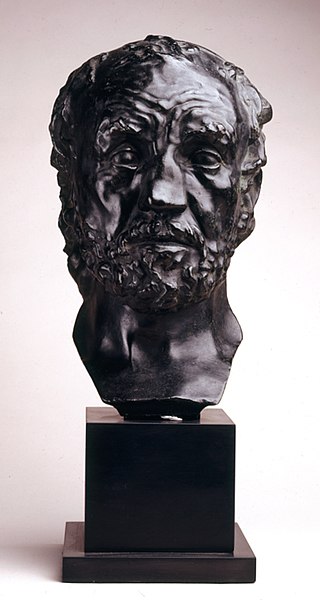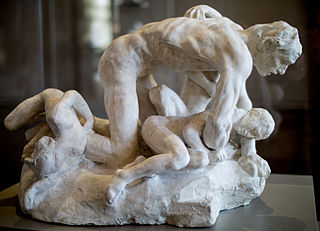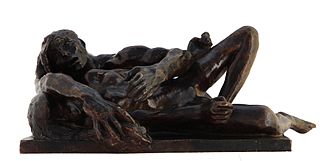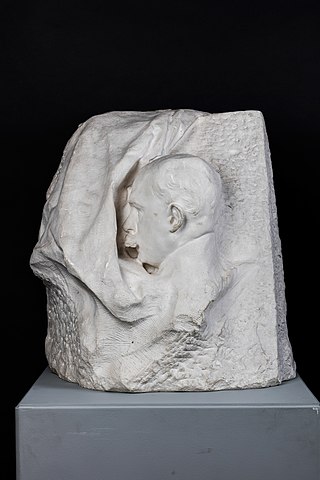
The Museo Soumaya is a private museum in Mexico City and a non-profit cultural institution with two museum buildings in Mexico City — Plaza Carso and Plaza Loreto. It has over 66,000 works from 30 centuries of art including sculptures from Pre-Hispanic Mesoamerica, 19th- and 20th-century Mexican art and an extensive repertoire of works by European old masters and masters of modern western art such as Auguste Rodin, Salvador Dalí, Bartolomé Esteban Murillo and Tintoretto. It is called one of the most complete collections of its kind.

Eternal Springtime is a c. 1884 sculpture by the French artist Auguste Rodin, depicting a pair of lovers. It was created at the same time as The Gates of Hell and originally intended to be part of it. One of its rare 19th-century original casts belongs to the permanent collection of Calouste Gulbenkian Museum.

Man with the Broken Nose is a sculpture by Auguste Rodin created between 1863 and 1864 and approved by the Salon in 1875. It is considered the first by Rodin in which life is represented over the grace pervading the academic circles and aesthetic of the time.

The Falling Man is a sculpture by French artist Auguste Rodin modeled in 1882 and is part of Rodin's emblematic group The Gates of Hell.

I Am Beautiful, also known as The Abduction, is a sculpture of 1882 by the French artist Auguste Rodin, inspired in a fragment from Charles Baudelaire's collection of poems Les Fleurs du mal.

Ugolino and his sons is a plaster sculpture by French artist Auguste Rodin, part of the sculptural group known as The Gates of Hell. As an independent piece, it was exhibited by its author in Brussels (1887), Edinburgh (1893), Genoa (1896), Florence (1897), Netherlands (1899) and in his own retrospective in 1900.

Avarice and Lust is a sculpture by French artist Auguste Rodin, conceived between 1885 and 1887, representing two of the seven capital sins and is part of his sculptural group The Gates of Hell, where it can be found in the lower part of the right door. It's possible that the name was inspired by Victor Hugo's poem Après une lecture du Dante:

Danaid is a sculpture by Auguste Rodin, based on the account in the Metamorphoses of Hypermnestra, eldest of the Danaïdes.

Andromeda is a sculpture by the French artist Auguste Rodin, named after Andromeda. It is one of the sculptures produced as part of his The Gates of Hell project and appears on the left door next to the personification of Day and on the right door as part of the group showing a falling winged genius.

The Old Tree is a plaster sculpture by the French artist Auguste Rodin, originally conceived as part of his The Gates of Hell project.

The Maiden Kissed by the Ghost is an 1880 sculpture by the French artist Auguste Rodin. It was first exhibited at his fourteenth exhibition, hosted by the National Society Salon. One of the marble versions of the work is now in the Museo Soumaya in Mexico City.

The Kneeling Man is a work originally conceived in 1888 by the French artist Auguste Rodin for his The Gates of Hell project.

Glaucus is a sculpture by the French artist Auguste Rodin, first conceived in 1886 as a representation of the mythological figure Glaucus, son of Poseidon. Originally made in plaster, bronze casts of it are now in the Brooklyn Museum and the Museo Soumaya.

Youth Triumphant is one of the sculptures created by Auguste Rodin as part of the planning for his The Gates of Hell. It was inspired by Jean Dampt's The Grandmother's Kiss, exhibited in 1893. That work shows a young woman resting in the arms of an old woman, with the pair deeply kissing.

Young Mother is a bronze sculpture by Auguste Rodin with a brown and green patina, conceived in 1885 and cast by the Rudier Foundry.

Ovid's Metamorphoses or The Satyrs is a sculpture by Auguste Rodin, created as part of The Gates of Hell.

Meditation or The Interior Voice is an 1886 sculpture by Auguste Rodin, showing a young woman resting her head on her right shoulder.

Paolo and Francesca is a sculptural group by Auguste Rodin, showing Paolo and Francesca da Rimini, damned lovers from Canto V of Dante's The Divine Comedy.

Octave Mirbeau is an 1895 plaster relief by Auguste Rodin of the writer Octave Mirbeau, now in the Museo Soumaya. He had got to know him thanks to The Age of Bronze and The Gates of Hell - Mirbeau visited Rodin's studio, published the first description of Gates in the review La France, promoted Rodin's other work and died only a few months before the sculptor.

Torso of Adele is an 1878-1884 sculpture by the French artist Auguste Rodin, originally modelled in plaster before being worked in terracotta.





















